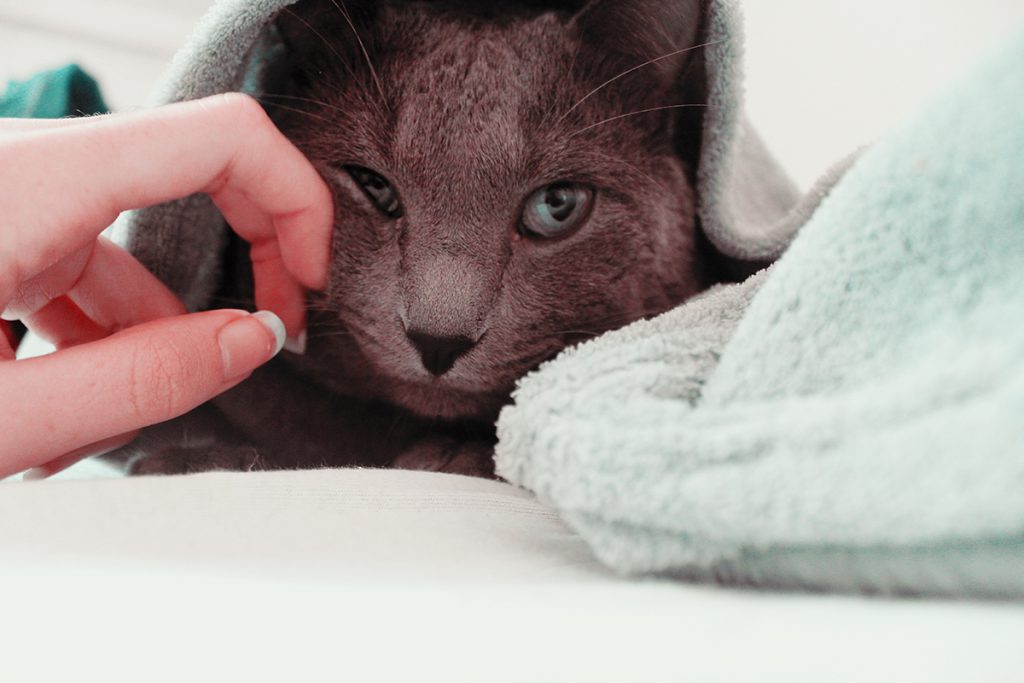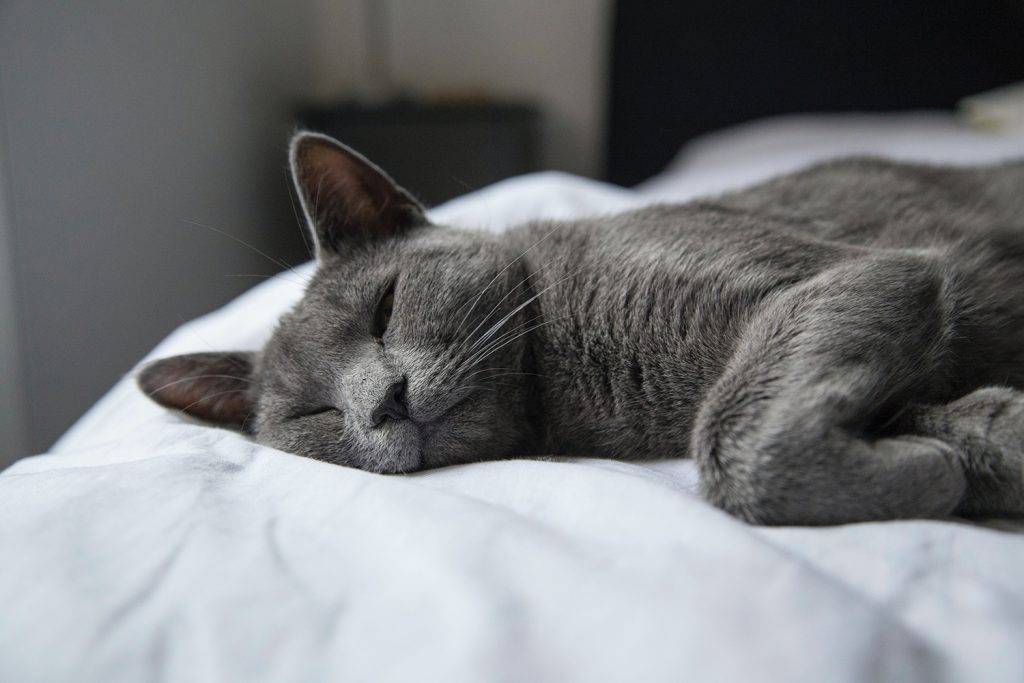
Six Cat Breeds That Cause the Least Allergies
26 Aug 2022.
It is a sad fact that many cat lovers find living with a kitty impossible because of allergies. But are there some hypoallergenic cat breeds that are less likely to trigger a reaction? Cat in a Flat finds out more.
Table of contents
Why do cats trigger allergies?
An allergic reaction happens when a person’s body treats a substance it comes into contact with as something dangerous. Their immune system is triggered to attack it, even if it’s something most people find harmless—such as contact with a cat, or pollen. This immune response is what causes swollen eyes, sniffles, and sneezing. For those unfortunate enough to have more severe allergies, reactions can include hives, rashes, wheezing and shortness of breath as well.
When it comes to your furry friend, you might think that it’s Mr Whiskers’ fur that makes you sneeze. But for most who have an allergy to cats, it is the proteins in feline saliva and skin particles (dander) that causes problems. More specifically, the Fel D1 protein in a cat’s saliva is what can trigger an allergic reaction. And it’s a common affliction: cat allergies are twice as common as dog allergies. So what can you do if you want to adopt a cat, but you can’t stop sneezing around them?

Are there cats that don’t cause allergies?
Unfortunately, a completely hypoallergenic cat is a myth. All felines produce Fel D1 protein—how much a kitty produces is what varies. There are some breeds that produce less of the protein and therefore are less likely to trigger allergies. Many cat lovers have been able to finally adopt a furry friend by finding a breed that doesn’t make them sneeze. Below, we look at six of the breeds known for causing less allergic reactions.
Important: Never assume a more hypoallergenic cat breed won’t cause any allergic reaction at all. The term refers to felines less likely to cause a reaction, but each cat and human is different. Some hypoallergenic cats can still provoke allergic reactions in some people. Anyone with allergies should spend time with their chosen cat breed, and preferably their specific cat, before bringing them into their home. The worst thing for all parties would be to have to give up a kitty due to allergies.
An interesting note on Fel D1 protein levels
As mentioned above, not all cats produce the same level of Fel D1 protein. Kittens produce less of the protein than adults. Female cats and neutered male cats produce less Fel D1 than unneutered male cats (which is one reason why neutering your cat is so important). However, female cats produce the same levels, whether spayed or not.
The top six cat breeds that trigger the least allergies
1. Sphynx Cats
Although hairless Sphynx cats produce Fel D1 protein, they shed less of it around the house because they don’t lose fur. Sphynx cats still have Fel D1 protein on their skin and in their saliva, so those suffering from cat allergies need to be careful to wash their hands before and after touching their kitty.

2. Siberian Cats
It might surprise you to learn that the long-haired Siberian cat is known for being one of the most hypoallergenic cat breeds. Although Siberian kitties sport long fur, they are actually one of the safest for the allergy-prone. This is because they produce some of the lowest levels of Fel D1 of any domestic cat breed.

3. Cornish and Devon Rex Cats
These cat breeds are quite unique because of their unusual curly fur. Cat fur usually comprises three levels – the outer guard hairs, middle awn hairs, and inner undercoat or down. The Cornish Rex only grows the undercoat of fur, while the Devon Rex cat grows the undercoat as well as some guard fur too. However, both types of kitties have very short, soft coats. While these breeds don’t produce less Fel D1 protein than other cats, they shed little and groom infrequently. This translates into less Fel D1 being released into the surrounding atmosphere.
4. Bengal Cats
Bengal cats are a popular breed for a reason. These felines are playful and smart, and boast beautifully sleek patterned coats that cat lovers around the world adore! Even better, Bengal cats can make great furry companions for allergy sufferers too. Like Cornish and Devon Rex cats, Bengals have very fine coats that require less grooming. They also shed little, which means a smaller amount of Fel D1 in the air than other breeds.

5. Russian Blue Cats
These striking silver-coloured cats have extremely plush, thick coats but are also said to have lower levels of Fel D1 than other breeds. Some also say that the thick, dense nature of Russian Blues’ fur keeps dander from being released into the air too.

6. Balinese Cats
This beautiful cat breed is also known as a longhaired Siamese. They might have fluffier, plusher fur than their Siamese cousins but they also produce less Fel D1 than other breeds, making them a better option for allergy sufferers.
Things you can do to manage your cat allergies
- Comb or brush your cat regularly — or ask someone less allergic than you to do it. Regular coat maintenance is an essential part of daily cat care and means less dander in your home.
- Don’t let your cat sleep on your bed. Many kitties love sleeping in bed with their owners, but if you suffer from allergies this is a no-no. As sad as it might be not to have bedtime kitty cuddles, keeping your furry friend out of the bedroom will help keep the sniffles at bay.
- Wash your hands frequently when handling your kitty, even if you have a hypoallergenic cat breed.
- Clean your home regularly and vacuum carpets and soft furnishings frequently. Make a particular effort to wash anything your cat touches, including their bedding and toys.
- Keep your kitty indoors. Cats can also carry other allergens, including pollen, on their fluffy coats. To avoid allergic reactions, try wiping your cat with a clean towel or cloth when they come in from outside. If possible, keep your kitty indoors. Not only will this help soothe your allergies, but your cat will be safe from many potential outdoor hazards, too.
- Change your kitty’s diet. What you feed your cat is important for their overall health. But did you know your fur friend’s diet could also have a positive impact on your allergies? By managing your cat’s diet, you can actually reduce the amount of active allergens in your environment by half!
Find out whether you should bathe your cat, and the secrets of fleas on the Cat in a Flat blog.
Remember to always brief your cat sitter on how to groom your kitty and take care of their luscious coat (or lack of one if you have a Sphynx!).
- #cat grooming
- allergic
- allergies
- cat allergies
- Cat Care
- hypoallergenic

